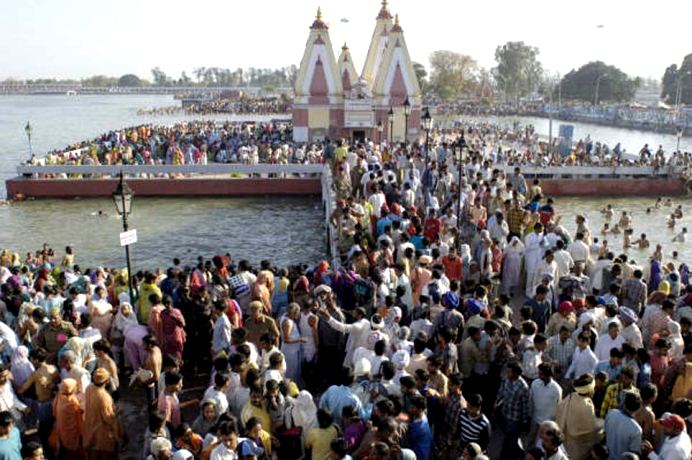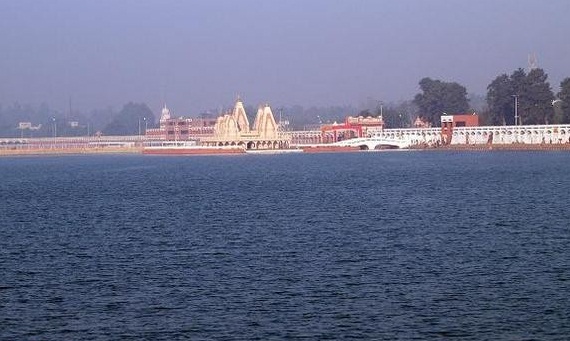Tourist Attractions in Kurukshetra:- The main tourist attraction in Kurukshetra is the Brahmasar or Kurukshetra Tank. There are also the remains of a Muslim Fort, including the Tomb of Shaikh chilli Jalal and Lal Masjid, a small red sandstone mosque. The carving on the domes is similar to that at Fatehpur Sikri.
Brahmasar or Kurukshetra Tank- This tank is about 1 km west of the town and about 1 km long. Many pilgrims came here to take a bath, but it is also visited by a wide range of wildfowl, during the winter. The tank is surrounded by temples and ghats (steps) leading down to the water edge. It also become the special focus of pilgrimage at the time of exceptional astronomical events. The solar eclipses in Kurukshetra are marked by special pilgrimages, when over one million people come to the tank from across northern India. It is believed that the waters of all India sacred tanks meet together in the Kurukshetra tank at the moment of eclipse, giving extra merit to anyone who can bathe in it at that moment.
Excursions
Thanesar- Thanesar, near Kurukshetra, is an ancient town and birthplace of the ruler Harsha Vardhana. Thanesar, originally known as Sthanvisvara became the launching pad for Harsha campaigns. Harsha father, a local chief had fought off the Huns besides feuding with his neighbors. From his capital in Thanesar, Harsha extended his territory from Bengal to Gujarat, and received tribute from as far a field as Assam. Thanesar was a Hindu pilgrimage centre and was sacked by Mahmud of Ghazni in 1011 AD.
Ambala- Ambala is situated about 50 km from Kurukshetra and lies on the Haryana and Punjab border on the road from Delhi to Chandigarh. During the British times, it became a large cantonment area and covered 78 square km, laid out from 1843 in grid fashion. The famous Gupta iron pillar which is now at the Qutub Minar in Delhi was originally placed on the hill just outside Ambala town before being moved by the Muslim rulers to its present position. Paget Park on the northern side of the city is a pleasant open space with the shell of St. John's cathedral, designed in 14th century Gothic style. It was bombed in the 1965 Indo–Pakistan war. The city is the headquarters of the district and an important wheat market.
Narnaul- Narnaul was once a place of faith, but, today, it is most definitely an earthly domain with its disorderly bazaars and chaotic streets. Narnaul is situated on the south-western tip of Haryana. Narnaul has some historic and architecturally significant buildings. The most interesting of these buildings is the five-storeyed Rai Mukund Das Chhatta, which Birbal one of the nine jewels of Akbar court, has visited very often. This building is built in stone and lime mortar, with a courtyard at its heart. This building also has ingenious lighting for underground rooms, as well as inventive water retrieval and storage systems. Adding to its mystery quotient is the rumour that underneath the building are long escape tunnels, some of which run as far as Delhi and Jaipur. The terrace affords unparalleled views of the town and the surrounding hills.
Pataudi- Pataudi is the home of the famous Pataudi Palace. The town gets its name from a Mewati chieftain, Pata, who founded it and named it Pataudi. Pataudi Palace, which has been turned into a heritage hotel, was built in 1935 to bring home the daughter of the Nawabs of Bhopal. It is undoubtedly a remarkable building but not open to tourists.
Farukhnagar- The Nawabs of Farukhpur were used as pawns by the British against Rajput rulers as part of their divide and rule strategy. After partition, they migrated to Pakistan, leaving behind their legacy of palaces, gardens and the famous Sheesh Mahal. The Sheesh Mahal has some unusual, intricate mirror decorations. This palace houses a jail that was also used as a torture chamber. Other places which can be seen in Farukhnagar are Ghaus Ali Shah shrine, Delhi Gate and the Salt wells.
How to get here- Kurukshetra is connected by road from Delhi, Chandigarh, Amritsar and Panipat.
Need Aspark Help?
For Tour Packages, Vehicle Rental and Customer Care Support.
+91 9999 31 7846
booking@asparkholidays.comWhy Travel with Us?

Excellent Support
Our Team Available 24x7 for Customer support
Best Price & Savings
We Offer the Most Competitive Prices.


